| 28-Dec-2014 |
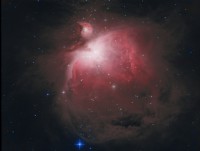
The iOptron CEM60 mount is officially operational.
Over the last two nights, I have taken my first image with the telescope on the new mount. I really like this mount. It is quiet and tracks smoothly. The guiding was really smooth, giving me the best guiding performance I have ever seen, and the guiding graph suggested that it can be improved even further with some fine tuning of the software.
The ASCOM driver software has some compatibility issues. iOptron is apparently working on a new release that will address those. I hope they hurry, because right now, I have to control the dome manually.
The stability of this mount and its weight capacity give me hope of being able to use the big C-11 telescope for photographing planets and small deep sky objects. Up until now, the weight of the big scope has prevented me doing that.
Before installing the CEM60, I took the opportunity to extend the pier by 6.5 inches. The CEM60 actually sits lower than the HEQ5 did, so I don't quite get the benefit of the full 6.5 inches of height: more like 5 inches. Still, that should allow me to see a few degrees lower over the sill of the dome slot.
|
| 20-Dec-2014 |
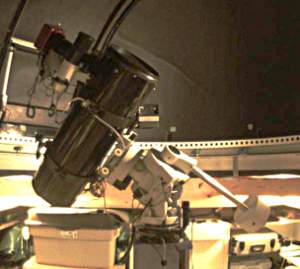
I have the CEM60 mount set up, and an performing some testing on it. It is amazingly quiet! When I have the portable heater running in the observatory, I have to look to see if it is moving, because is is not audible over the sound of the fan. That is a pleasant change from the washers-in-a-paint-can sound of the HEQ5!
I have not yet used it for observing. For one thing, the weather has not cooperated. Also, there are some technical hassles to sort out. The cable management system uses a non-standard power plug (2.5mm instead of the normal 2.1mm), so I have a temporary connection (2.7mm) there while I wait for the right plug to come in.
The driver that came with it only allows one piece of software at a time to connect to it. Since my dome software controls the power, I have to start it first, but it attempts to connect to the mount right away. The attempt is unsuccessful, since it has not yet turned the power on, but it ties up the driver, preventing me from connecting any other software to it. In particular, it prevents the firmware upgrade software from connecting, preventing me from upgrading to a version that does not have this problem. There are ways to work around this, enough to keep me busy for a few more days.
With the cable management system, almost all my cables now connect to the declination head of the mount, meaning that there are no flex loops hanging from the telescope. The only flexing cables are the power cable (the one that needs the special plug) and the USB cable, both of which connect near the RA axis, where motion is limited.
The one exception to using the cable management system is the video camera USB cable. There are too many USB hubs in the normal USB connection to run video through, so it has its own USB cable that hangs from the scope. This keeps its connection down to two USB hubs. The rest of the devices have one hub in the active USB cable to the pier, two (a 7-port external hub using two hubs in series) at the pier head, and another hub in the cable management system. Plus one in the computer itself, for five total. I should be able to cut this down by one by using a smaller hub at the pier head.
In other news, I ordered the electrical parts I need to begin building my dome controller. I will be happy to get rid of the system I am running now. I noticed another bit of flakiness in the AstroMC software this week: It can't remember my longitude! No matter how many times I tell it that I am at 66 degrees west, it thinks I am randomly anywhere from 62 to 67 degrees west.
I had a couple of equipment failures this week. A USB hub croaked on me. Fortunately, I had some unused ports on the computer, and I was able to reconfigure the cables to free up another hub with which to replace the failed one. Also a USB-to-One-Wire adapter failed. It had been a little flakey for years, so its failure is not a total surprise. It means that my power management system and rain detector are out of action until the replacement ararives.
|
| 04-Dec-2014 |
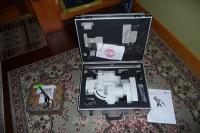
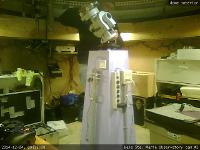
Yesterday, my new iOptron CEM60 mount arrived. This mount has a payload capacity of 60 lbs, double that of my HEQ5 mount. It will allow me to use the C-11 scope for astrophotography, something I have not been able to do until now.
Today, I stripped down the HEQ5, assembled the new pier plate, and installed the CEM60 on the pier.
I still have some work to do. I cannot yet balance the C-11 properly; I will have to get another counterweight for that. I have to make up a power cable to feed the accessory outlets. And I have to install the driver software.
I am very pleased with the CEM60. It is very well designed, and well engineered.
|
| 09-Nov-2014 |
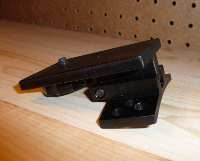
While waiting for my CEM60 mount to arrive, I was planning what combinations I will be able to load onto it. One combination would be a small-DSO imaging setup, using the C-11 as the imaging scope and the C-90 as the guide scope.
I searched online and had not yet found a piggyback adapter suitable for the job. The ones I found were either too flimsy or too expensive.
Well, today, I was rummaging through a box of parts that came with the C-11 OTA. They were mostly counterweight hardware from back when it was fork-mounted. Since I use a dovetail for balancing now, I hadn't paid much attention to the contents. Imagine my surprise when I found a very nice, sturdy piggyback mount piled in with the counterweights!
|
| 01-Nov-2014 |
I may have finally found an answer to the meridian flip problem. Apparently, there is a new setting in a new version of the EQMOD software that you have to select to make it work. Unfortunately, it is the same setting the dome software was having problems with a few months back. So, if I upgrade EQMOD and fiddle with that setting (called "side of pier"), I run the risk of breaking the dome synchronization. *Sigh*
|
| 18-Oct-2014 |

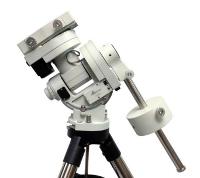
New Mount
I am about to upgrade the mount in the observatory.
I have been using a Skywatcher HEQ5. It is a fine mount, but it is rated for only 30 lbs. The C-11 that I use for visual observing and planetary imaging is 30 lbs, and the 8" Newtonian, with its cameras, that I use for DSO imaging, is over 25 lbs. Since the rule of thumb for imaging is to keep the payload down to 50-60% of the mount's load rating, it is clear that I am pushing the HEQ5's limits severely.
The new mount is the iOptron CEM60, which is rated for a 60 lb payload. It will easily accommodate either rig, and will allow other options as well, such as piggybacking a camera on one of the scopes.
I ordered it today, along with the matching pier adapter plate. The mount should be here in a couple of weeks. The pier adapter will take a couple of weeks longer. The difference in timing will give me an opportunity to modify the pier to raise the scope relative to the dome opening.
The old HEQ5 will now become my portable mount for star parties.
Dome Control
I have finally made the decision to scrap the Foster dome controls and replace them with my own. I have designed a relay-based control system that minimizes the level of technology required, and improves the ability to shut down quickly in a rain emergency.
The new system will use the ASCOM driver that I was working on a couple of months ago.
The emergency close function will be implemented entirely in hardware, with no assistance from the computer. The computer will simply be notified that the emergency close is happening. For such a critical function, this is the only way to do it.
Development and testing will take several months, during which time I will continue to make do with the Foster controls.
|
| 13-Oct-2014 |
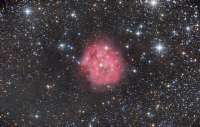
Last night was a bit of a hair-puller. Clear sky, great weather, tech hassles. For reference, the result is above.
My objective was to have SGP run a session with an automatic meridian flip. The session started out okay, with PHD2 auto-selecting a guide star and calibrating itself. But, once calibrated, it couldn't guide to save its life. Well, it stayed close enough to on-target, but the graph was all over the place. The RMS was around 0.3, instead of my normal 0.1 or less. It took me 20 minutes of hassling with it before I noticed that the exposure time was 1 second. Normally, I keep it at 2 seconds. I had reduced it the other day while working on the guide scope's focus. You wouldn't think that that would make a big difference, but it did. Once I reset it back to 2 sec, the graph smoothed right out. It had been "chasing the seeing" at 1 second.
Came time for the flip, and SGP correctly anticipated it, suspending the frame that would have crossed the meridian. So far so good. I recall one of the corollaries of Murphy's Law: "If everything appears to be going according to plan, you have obviously overlooked something." It tried to slew the scope, but EQMOD doesn't accept slews to the other side of the mount until the object is more than a minute or so past the meridian. So the sequence aborted.
A minute later, I resumed the sequence, and the slew went fine. But the dome takes a few seconds longer to catch up, so the verification plate-solve frame that SGP took was of the inside of the dome! Another abort.
SGP isn't good at distinguishing an abort (that is likely to be resumed once the problem is fixed) from completion. It wouldn't let me resume the sequence after that, telling me that it was finished. I had to re-load the sequence and disable the frames that were already done. After which, the rest went smoothly.
The hassling cost me several frames, but I was able to salvage the image. My next project will be to fiddle with SGP's Meridian flip parameters to see if there is something I can use to delay it for the dome slew. I have 11 days left in my free trial. Fingers crossed.
|
| 29-Sep-2014 |
I spent yesterday afternoon beating on the various software packages to find a combination that will allow the dome to stay synchronized to the mount all evening. I did finally get a combination that works. So now I no longer have to actively babysit the session.
After some rummaging around on the Internet, I found some software that interfaces Sequence Generator Pro to the same database as AstroTortilla (cygwin). It installs it in a different location, so I now have two copies on my disk (at 420Mb each), but at least it is reliable. I tested it successfully with existing images. The real test will be with live images from the camera, but I am optimistic that it will work.
That makes SGP a viable product. I hope I get a chance to try it out before my trial expires. I am looking forward to running sequences that involve a meridian flip, and sequences with multiple targets.
|
| 27-Sep-2014 |
This late summer / early fall weather is ideal for astronomy. I have had nine imaging evenings since the beginning of September. The last few have been blessed with good seeing, good transparency, and no moonlight!
The only drawback has been that I have no time to beat on the software. The dome driver is acting up again, refusing to track the scope. It synchronizes on the initial connection, but then does not update its position. So, every five minutes or so, I have to disconnect it and reconnect to keep it tracking. I am waiting for a moonlit evening, when serious astrophotography is a waste of time before tackling it.
I have also been testing new capture software: Sequence Generator Pro. It has great potential, if I can get it to work. So far, it has failed to communicate with the dome, and is unreliable at plate solving. I would like to get it working, because it has the potential to automate meridian flips and acquire multiple targets. That would allow me to take advantage of clear nights by doing all-night sessions.
Another moonlight project.
|
| 04-Sep-2014 |
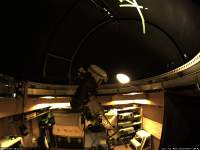
Success!
My session monitoring software successfully shut down after last night's session. When I woke up this morning, the dome was closed and parked, the mount was parked, and the software was shut down except Nebulosity, which was keeping the camera cold in preparation for taking flats this morning!
|
| 03-Sep-2014 |
Dome controls update
I completed writing and testing the ASCOM driver for the new home-made dome controller that I wrote about in the last entry. The driver passed its ASCOM conformance tests, and the electrical circuitry has been designed.
But the Foster controls kind of work, and I don't feel like doing all the work of ripping them out and replacing them right now. The dome would be out of action during the work, and right now is the best time of year, weather-wise, for observing.
Session Monitoring
Instead, I have been working on my Session Monitoring software. It performs two important functions: controling battery charging between sessions, and ensuring timely and safe shutdown at the end of a session.
The Battery Monitor function checks the voltages on my three batteries every five minutes. When the voltage on any battery drops to a predetermined level, the battery is automatically charged. The latest update allows a battery whose voltage is low to pre-empt the charger from a battery that is currently being charged.
The Session Monintor function takes care of shutting down at the end of a session. It took quite a bit of work (and some bad language) to get it to work with the Foster controller. However, I am satisfied that it is now reliable.
It will initiate a shutdown at a predetermined time. This is the normal mode of operation when imaging. It will also initiate a shutdown if rain or high winds are detected. And there is a software panic button to manually trigger a shutdown.
On a shutdown, the first priority is to close the dome. It also parks the mount and shuts down the astronomy software.
I have run several overnight photo sessions with the dome-closing function operational. I have now tested the other functions several times and am ready to try them out on live sessions.
|
| 10-Aug-2014 |
A Review of the Foster Dome Controller
I am planning to replace the Foster dome controls. They have been nothing but trouble since day one.
Though the controller hardware looks professionally designed and built, the software is amateurish. Documentation and support are virtually nonexistent, consisting of a rudimentary installation guide and a web forum with almost no traffic.
Good features of the Foster control system are the wireless communication between the rotation controller and the shutter controller, and the automatic throttling of the upper door motor as the door free-falls down the back of the dome on opening.
However, the negatives outweigh the positives.
The rotation controller, which is the master unit if the pair, has an input for "Weather Trigger". I would guess that this was intended to accept some kind of signal indicating that the weather was unsafe. Or maybe it is an output from a connected weather station. Presumably the astronomer who created the hardware specification and the electronic engineer who designed the hardware knew what it was used for. But no one else knows. It is, of course, totally undocumented.
There is also a power jack on the controller board, labelled "9V". There is no mention anywhere of what it is for. It is possible to guess, based on the documented ability of the controller to detect a power failure, that this is where the power or lack thereof is detected. And the guess would turn out to be correct. But one hates to guess with expensive electronics.
The AstroMC software that consitutes the driver for the Foster controls is flakier than a bowl of granola. For example, there is a big button in the form labelled "All Stop". A useful concept in principle, but it is totally non-functional.
The Setup form can only be visited reliably once per session. If you select Setup a second time, you run the risk of AstroMC disappearing. But it doesn't shut down completely, thus blocking starting up a new incarnation. You have to kill it in Task Manager to escape.
Similarly, if you open the Power Control form, it will have the controls properly labelled with the customer's captions the first time. Visit the form a second time, and the customer labels are gone.
One could live with glitches like that if the software performed its primary function of synchronizing the dome to the mount under control of ASCOM software. Unfortunately, both ASCOM ans AstroMC are painfully sensitive to version changes. Only certain combinations of EQMOD, ASCOM and AstroMC versions interpret (or misinterpret) the ASCOM specifications in a manner that allows compatibility. I had to experiment with many combinations of versions before I found one that would track properly in the northern half of the sky.
Even that only lasted for a while. Out of the blue, it stopped tracking. Now, I have to keep diconnecting and reconnecting the software in order to keep the dome synchronized.
If there were support available for the system, it would be worth working with it to trace the fault and fix it. But there is no support. If you email the support line, you get an auto-reply saying that they will try to respond within two weeks. Apparently, they don't try very hard. I never heard back.
So, the bottom line is that the Foster dome controls are not a good investment. I have a project under way now to build my own controller and write my own ASCOM driver for it.
|
| 02-Jul-2014 |
I have completed my power control unit and the associated software for it.
The unit consists of an interface board with 8 computer-controlled relays, an analog-digital converter, a rain detector, and some extra stand-alone relays. With it, the software can monitor the voltage in all three system batteries, and can charge then when they need it.
The system automatically detects when an observing session begins, by monitoring the voltage sent to the pier-mounted systems (cameras, mount, etc.) When it detects that the pier power is live, it switches over from battery-charging to session monitoring.
In session monitoring mode, it allows me to set a shutdown time. At the shutdown time, it will automatically close the dome and power down the pier systems. It also monitors the weather data from my weather station and from a stand-alone rain alarm. If either the weather station or the rain alarm detect rain, the software will again close the dome and shut down the pier systems. It will do the same in the event of a power failure.
With this system up and running, I can now leave the observatory unattended once I have started a photo session. I have already been running my sessions from indoors, but I had to stay up to close the dome at the end of the session. Now, I can get everything set up, start the image run, and then go to bed, knowing that the observatory will take care of itself.
This afternoon, it passed the "spit test". With the dome open, I licked my finger and touched the rain detector. Immediately, it started beeping. Within a few seconds, the dome shutters closed.
|
| 18-May-2014 |
I completed the mount-dome calibration measurements. There are issues with software that does or does not comply with the ASCOM standards for doing these calculations. Surprisingly, it is the non-compliant software that works best. I have done a photo session with the dome tracking the scope, and it works, as long as I don't try to track in the north sector.
As of today, the automation project is complete(-ish)! I have run the doors through several complete open/close cycles successfullyWhew! That was a project and a half!
I still have a few tweaks to make. I have yet to build some of my own circuitry that will provide rain protection, battery charging, a rotation safety interlock, and similar functions.
But the door works!
The Exploradome automation "kit" is not for the faint of heart. They change the design of parts more often than most people change their underwear. The instructions can't keep up. The nuts and bolts they supply don't match either the parts list or the instructions. So a fair amount of improvisation is required. When they added the black lining to the dome, which adds about 1/8" to the thickness of the dome, they didn't increase the lengths of the bolts correspondingly. So some of them don't quite reach their washers or nuts, requiring trips to the local hardware store.
Some of the installations require helpers or extreme ingenuity. For one set of screws, I had to wire my wrench to the motor bracket to hold the nut on the inside while I went outside, climbed up on the roof, and reached over to the top of the dome to drive the screw. (See photo 1, below.) The bracket for the door limit switches goes into such a confined space that there is not enough space to get even a stubby screwdriver in. You have to hope there is enough friction that you can hold the screw with a fingertip.
The electronics that control the automation system appear to be well designed, and work well. Too bad the dog ate the manual before it was published, though. There are functions on the controller board that are not documented anywhere. One presumes that the astronomer that laid out the specification and the electronics engineer who designed the controller had some idea how these functions were supposed to work, but they are not described anywhere. There is no tech support available.
Still, the system works!!
|
| 23-Apr-2014 |
Over the winter, I accumulated the parts for the dome automation system. It's a kit, but they don't necessarily ship you all the parts the first time, hence "accumulated".
The system is battery-operated, in order to provide an emergency shut-down capability in the event of a power failure, and as a practical measure to provide power to the shutters in the rotating dome. I have the charging system in place, thanks to a perfectly good $350 charger that I picked up for $10 at the locak junk store. :)
This week, I got the rotation system operational. I still have to bolt the motor in place - it is just held in place with clamps right now - but the software is working (after much hair-pulling and cursing). I had Cartes du Ciel (planetarium software) track an object with the telescope, and the dome kept up with it.
I still have some calibration to do. The mount doesn't hold the telescope in the exact cenntre of the dome, so the software needs to know several important measurements of the mount in order to position the dome slot accurately.
Once the calibration is done, I will be able to warm up indoors while a photo session is running.
The next step is to install the shutter system. It will open and close the dome shutters automatically. The major benefit is the ability to have the dome close up automatically at the end of a session, or in the event of bad weather. With that system operational, I will be able to start session from indoors, and go to bed while it runs.
|



